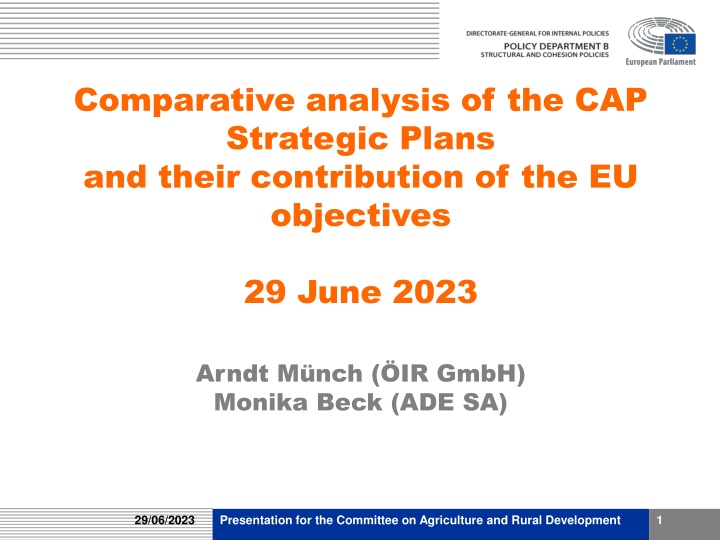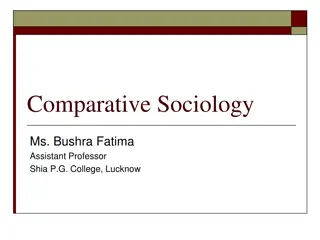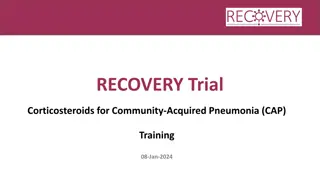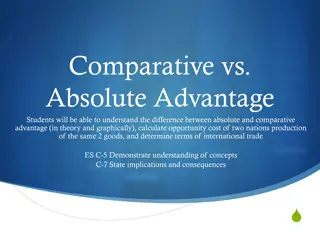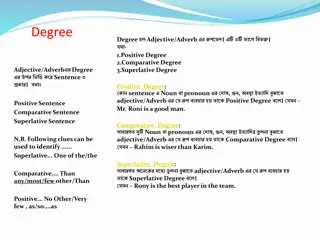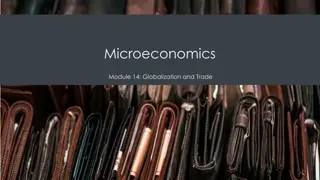Comparative Analysis of CAP Strategic Plans: EU Objectives Contribution
This presentation analyzes the CAP Strategic Plans for their contribution towards EU objectives, focusing on priorities, interventions, relevance, and the new delivery model. Recommendations are provided based on the study's findings.
Download Presentation

Please find below an Image/Link to download the presentation.
The content on the website is provided AS IS for your information and personal use only. It may not be sold, licensed, or shared on other websites without obtaining consent from the author.If you encounter any issues during the download, it is possible that the publisher has removed the file from their server.
You are allowed to download the files provided on this website for personal or commercial use, subject to the condition that they are used lawfully. All files are the property of their respective owners.
The content on the website is provided AS IS for your information and personal use only. It may not be sold, licensed, or shared on other websites without obtaining consent from the author.
E N D
Presentation Transcript
Comparative analysis of the CAP Strategic Plans and their contribution of the EU objectives 29 June 2023 Arndt M nch ( IR GmbH) Monika Beck (ADE SA) 29/06/2023 Presentation for the Committee on Agriculture and Rural Development 1
Structure of the Presentation Structure of the Presentation 1. Scope of the study 2. Priorities and interventions of the Strategic Plans 3. Relevance of the Strategic Plans and contributions to national & EU objectives 4. Added value of the new delivery model 5. Recommendations 29/06/2023 Presentation for the Committee on Agriculture and Rural Development 2
1. Scope of the study 1. Scope of the study Objectives of the study Provide insights into the implementation characteristics of the CAP 2023- 2027 across the Member States and to assess the relevance of the plans and their contributions to the CAP and Green Deal objectives. Timing: December 2022 to early May 2023 Methodological approach Desk review of the literature, technical and policy reports and regulatory background Expert review and machine analysis of the 28 CSPs, ex-ante evaluations and observation letters Analysis of European Commission DG AGRI extract of the SFC2021 database (funding data, result indicator targets) Cluster analysis of the CSPs Focus groups with the European Commission DG AGRI 29/06/2023 Presentation for the Committee on Agriculture and Rural Development 3
2. Priorities and interventions 2. Priorities and interventions of the Strategic Plans of the Strategic Plans The CAP 2023-2027 unifies Pillar I and II into single Strategic Plans Single strategic documents (CSPs) with common performance frameworks Green shift foreseen: eco-schemes, AECM and strengthened conditionalities Administrative simplification SO1 SO2 SO3 General objective 1 Smart, competitive, resilient and diversified agricultural sector Fair income for farmers Fostering competitiveness Improving the position in the value chains CCO Fostering knowledge and inno- vationand digitalisation SO4 SO5 Natural resources SO6 General objective 2 Strengthen environmental protection, biodiversity and climate action Climate change action Protecting landscapes and biodiversity SO7 SO8 SO9 General objective 3 Socio-economic fabric of rural areas Generational renewal Vibrant rural areas Food quality, animal welfare, anti- microbial resistance 260 bn in EU funding for 2023-2027; 75.4% EAGF, 24.6% EAFRD CAP Strategic Plans EAGF EAFRD Comprehensive approval process via structured dialogues Uniform methodological framework for EC recommendations Draft CSPs and observation letters: general willingness to incorporate EC observations, however, less so for more substantial observations Final approval in late 2022 29/06/2023 Presentation for the Committee on Agriculture and Rural Development 4
2. Priorities and interventions 2. Priorities and interventions of the Strategic Plans of the Strategic Plans Direct payment planned 2023-2027 EU-27 Direct payments remain the main funding vehicle of the CAP 187 bn direct payments (62%), 107 bn rural development (35%), 5 bn sectoral (3%) in terms of total funding 11 MS transfer from DP to RD; 6 MS transfer to DP Direct payments during 2023-2027 Significant increase in redistributive payments and CIS, introduction of eco- schemes Slight decrease in importance of BISS Capping/degressivity applied by 11 MS compared to 22 in 2014-2022 158 eco-schemes across the EU (arable land: 113, 86 grassland, 69 permanent crops) Eco-scheme complexity is high with variation across MS. They complement AECM from Pillar II Art. 32 - CIS 12.3% Art. 31 - Eco- schemes 23.8% Art. 21 - BISS 51.5% Art. 30 - CIS-YF 1.8% Art. 29 - CRISS 10.7% 29/06/2023 Presentation for the Committee on Agriculture and Rural Development 5
2. Priorities and interventions 2. Priorities and interventions of the Strategic Plans of the Strategic Plans 78 - KNOW , 1.9% Sectoral support makes up 4.5% of EAGF Wine & fruits and vegetables make up 46% each Small share by Apiculture (3.2%), olives (2.45%), hops (0.12%) and others 77 - COOP , 10.4% 70 - ENVCLIM , 76 - RISK , 4.3% Rural development funding is marked by great diversity across the EU-27 Agriculture, including agri-environment and climate support, remains focus of EAFRD Young farmer support shifted from EAFRD to EAGF in 2023-2027 Risk management sees increased prominence compared to previous period Rural development beyond farming is mostly supported via LEADER National co-financing varies 12-80%; EU average co-financing 60% 75 - INSTAL , 4.8% 71 - ANC , 17.5% 73-74 - INVEST , 29.3% 72 - ASD , 0.8% 29/06/2023 Presentation for the Committee on Agriculture and Rural Development 6
3. Relevance of the Strategic Plans and 3. Relevance of the Strategic Plans and contributions to national & EU objectives contributions to national & EU objectives The relevance of the CSPs is high in terms of economic needs and moderate for rural development and for environmental needs The relevance of the CSPs is high in terms of economic needs and moderate for rural development and for environmental needs according to the ex-ante evaluations. Economic and environmental needs are emphasised across the 28 CSPs and are appropriately targeted. Rural development needs, while prominently outlined in the CSPs, are often targeted outside of the CAP. Target setting of CSP interventions generally in line with needs, however not consistently ambitious in relation to environmental needs Great diversity of green architecture approaches (AECM, eco-schemes, strengthened conditionality) Member States tailored the CSPs to their needs and preferences. Flexibility of framework produced very tailored CSPs positive in terms of national relevance Significant needs are targeted via policies outside of the CAP (e.g. RRF): irrigation, broad-band, energy efficiency, renewable energy, risk management and forestry 29/06/2023 Presentation for the Committee on Agriculture and Rural Development 7
3. Relevance of the Strategic Plans and 3. Relevance of the Strategic Plans and contributions to national & EU objectives contributions to national & EU objectives Changes in the CAP Strategic Plans due to the Russian invasion of Ukraine Major changes due to war to the fundamental character of the CSPs remain limited Strong re-emergence of CIS, such as to livestock farming, across 9 CSPs as justified by war Justification for risk management in more limited number of 4 CSPs Contributions to the European Green Deal Contributions to EGD goals in CSPs: non-binding commitments, MS goals are not quantified Major contribution potential along climate and environmental goals due to emphasis on eco-schemes & AECM (esp. via organic farming), strengthened conditionality and no backsliding Capacity to deliver on EGD goals will depend on implementation of interventions tied to green architecture, particularly the uptake of eco- schemes 29/06/2023 Presentation for the Committee on Agriculture and Rural Development 8
4. Added value of the new delivery model 4. Added value of the new delivery model Simplification and its costs The CAP remains complex particularly due to the remuneration of the production of public goods, requiring additional efforts in monitoring Digitalisation and easier application procedures should reduce administrative costs in the long-run Significant short-term costs may arise from introduction of new model Evaluation in 2023-2027 Reduced EU-level requirements on evaluation questions and timing of evaluations may lead to more heterogeneous approaches across the EU The PMEF is a key element in the new delivery model, however the indicator system appears incomplete Improvement in comprehensiveness and coherence: Common CAP indicators; systematic link to SOs, reduction in number (210 to 148 RI). However, some RI that relate to committed areas, are not able to fully capture the effectiveness of the intervention particularly eco-schemes and redistributive payments 29/06/2023 Presentation for the Committee on Agriculture and Rural Development 9
5. Recommendations 5. Recommendations Member States are recommended to support and promote the uptake of more ambitious eco-schemes to effectively address climate and environmental needs. Member States are recommended to start evaluations of the Strategic Plans at the earliest possible stage to be used for the design of the CAP 2027+. A systematic EU-27 assessment of administrative burden is recommended to investigate whether administrative simplification and increased digitalisation has been effective in reducing burden. Comprehensive evaluation efforts are recommended to: Capture the results and impacts of national and EU policies targeting CAP goals in the Member States Mitigate the shortcomings of the PMEF in capturing results of CAP interventions 29/06/2023 Presentation for the Committee on Agriculture and Rural Development 10
Thank you for your attention! Further information: Arndt M nch IR GmbH muench@oir.at +43 1 533 87 47-49 Monika Beck ADE SA Monika.Beck@ade.eu +32 1 048 94 62 29/06/2023 Presentation for the Committee on Agriculture and Rural Development 11
